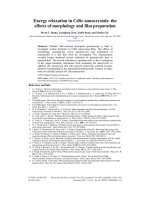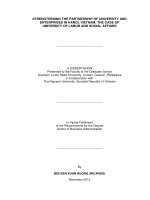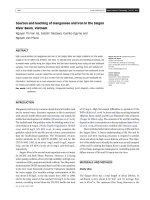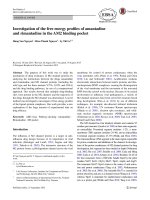interation of morphology and syntax in american sign language
Bạn đang xem bản rút gọn của tài liệu. Xem và tải ngay bản đầy đủ của tài liệu tại đây (10.5 MB, 263 trang )
ROUTLEDGE LIBRARY EDITION:
SYNTAX
Volume 18
INTERACTION OF MORPHOLOGY
AND SYNTAX IN AMERICAN SIGN
LANGUAGE
INTERACTION OF MORPHOLOGY
AND SYNTAX IN AMERICAN SIGN
LANGUAGE
CAROL A. PADDEN
First published in 1988 by Garland Publishing, Inc.
This edition first published in 2017
by Routledge
2 Park Square, Milton Park, Abingdon, Oxon OX14 4RN
and by Routledge
711 Third Avenue, New York, NY 10017
Routledge is an imprint of the Taylor & Francis Group, an informa business
© 1988 Carol A. Padden
All rights reserved. No part of this book may be reprinted or reproduced or utilised
in any form or by any electronic, mechanical, or other means, now known or
hereafter invented, including photocopying and recording, or in any information
storage or retrieval system, without permission in writing from the publishers.
Trademark notice: Product or corporate names may be trademarks or registered
trademarks, and are used only for identification and explanation without intent to
infringe.
British Library Cataloguing in Publication Data
A catalogue record for this book is available from the British Library
ISBN:
ISBN:
ISBN:
ISBN:
978-1-138-21859-8
978-1-315-43729-3
978-1-138-21289-3
978-1-315-44968-5
(Set)
(Set) (ebk)
(Volume 18) (hbk)
(Volume 18) (ebk)
Publisher’s Note
The publisher has gone to great lengths to ensure the quality of this reprint but
points out that some imperfections in the original copies may be apparent.
Disclaimer
The publisher has made every effort to trace copyright holders and would welcome
correspondence from those they have been unable to trace.
Interaction of Morphology
and Syntax in American
Sign Language
Carol A. Padden
Garland Publishing, Inc. • New York & London
1988
Copyright @ 1988 Carol A Padden
All Rights Reserved
Library of Congress Cataloging-in-Publication Data
Padden, Carol.
Interaction of morphology and syntax in American sign language I
Carol A Padden.
p. em. -(Outstanding dissertations in linguistics) Thesis (Ph.D.)
Bibliography: p.
ISBN 0-8240-5194-7
1. Sign language. 2. English language-Syntax. 3. EnglishMorphology. I. Title. II. Series.
HV2474.P34 1988
88-16413
419--dc19
Printed on acid-free, 250-year-life paper
Manufactured in the United States of America
Preface
I have elected to include here the text of my dissertation in its original
form with minor copy corrections. In the five years since its completion,
there have been, not surprisingly, a number of significant proposals
concerning American Sign Language structure which in some cases
improve on those I have offered here. As tempting as it might be to to try to
recast my descriptions and conclusions in a more modem light, the task
would involve much too drastic a change to the dissertation itself. Instead, I
have opted to retain the original text with letter footnotes directing the
reader to more recent discussions. I do this as a means of highlighting the
sometimes slow, occasionally circuitous, but significant progress made
over the last twenty-five years toward the description of signed languages.
One significant set of new proposals concerns the description of the
morphophonology of verbal affixes. Although Chapter 2 describes in
considerable detail the different verb classes and the categories of affixes
which attach to verbs, it is purposely vague about the form of the affixes
themselves: are they prefixes, suffixes, or in what manner to they attach to
roots? Such omissions would be atypical in oral languages, but in a field
with such recent history, these gaps are painfully necessary. The
descriptions in Chapter 2 suffer from a failing common to descriptions of
its time: signs are described minimally in terms of their segmental structure.
We now know that internal structure of signs contains at least one
segmental tier to which a complex array of other tiers are attached, each tier
consisting of a unique set of features (Liddell 1984, Liddell & Johnson
1986, Sandler 1986a,b, Perlmutter 1986, Perlmutter 1987). While details
about the number of tiers and their composition have yet to be worked out,
it is clear that any description of verbal morphology needs to at least
acknowledge the ongoing discussion of the form of roots and affixes in
ASL.
Another recent proposal tackles a descriptive problem perhaps unusual
to signed languages, the visible spatial dimension that signs exploit (LilloMartin & Klima 1986). The standard treatment for describing pronominal
forms and agreement affixes in ASL, repeated here in Chapter 2, is to enter
in the lexicon an infinite number of possible forms. Pronouns and
agreement affixes in ASL reference different points in space: third-person
pronouns, for example, involve "pointing" in conceivably any direction
around the signer's body. Lillo-Martin & Klima have proposed a
modification, briefly explained in a letter footnote in Chapter 2, which
attempts to overcome this apparently unusual feature of ASL. One impact
of this modification is that unlike previous treatments, the lexicon does not
contain first, second, or third person agreement markers or pronouns.
Another indicator of the ongoing descriptive issues in signed languages
can be seen in the notational system used in this text. The notational system
used here is an adaptation of ones used in earlier work by others; the
conventions also reflect earlier assumptions: the notation records a
distinction between first, second and third person agreement markers and
pronouns. (See Lillo-Martin 1986 for a recent modification of these
conventions.) Additionally, although the notational system suggests a
segmental treatment of roots and affixes (agreement markers appear in
sequence before and after the root), the treatment is not structurally accurate
for the reason that the conventions are not based on a language-independent
system, instead on English glosses. For obvious reasons, segmental and
other structural information should not be inferred from the conventions
used to represent ASL morphology since at best, they can only suggest, not
represent. These cumbersome conventions, some of which continue to
appear more recent work by others, will need to serve until such a time
when a writing system for signed languages is developed. The fact that
there are several serious projects at present to develop a writing system
testifies to the work that has been completed and the work which yet
remains. This dissertation and its treatment of morphology and syntax in
ASL is one step in this sequence.
Table of Contents
Page
Notational Conventions
List of Figures
Acknowledgements
1
5
8
Introduction
9
1
Relational grammar
14
1.1
1.2
1.3
1.4
Basic concepts
Clause structure
Constructions, rules, and laws
Why relational grammar
14
15
19
23
2
Verb classes
25
2.1
2.1.1
2.1.2
2.1.2.1
2.1.2.2
2.1.2.3
2.2
2.3
2.3.1
2.3.1.1
2.3.2
2.3.2.1
2.3.2.2
2.4
Inflecting verbs
Person agreement
Number agreement
Dual
Exhaustive
Multiple
Plain verbs
Spatial verbs
Arguments against person agreement for Spatial verbs
Reciprocal
Arguments against number agreement for Spatial verbs
Multiple
Exhaustive
Test cases: "Irregular verbs
Footnotes to Chapter 2
26
28
31
31
33
35
37
40
41
45
47
47
48
51
55
3
Embedded structures
84
3.1
3.1.1
3.1.2
3.1.3
3.1.4
Arguments for embedded structures
Subject pronoun copy
Negative marking
Topicalization
Conjunctions/Discourse markers
Footnotes to Chapter 3
84
86
89
90
94
97
98
4
Predicates
4.1
4.1.1
4.1.2
4.1.3
4.2
4.2.1
4.2.1.1
4.2.1.2
4.2.2
4.2.2.1
4.2.2.2
4.2.2.2
Distinctions between grammatical categories
Adjectives
Nouns
Verbs
"Predicate" as a grammatical relation
Arguments for predicatehood
Sentential complements
Short answers
Distinction between predicate and attributive adjectives
Resultative inflection
Adverbs
Facial adverbs
Footnotes to Chapter 4
98
100
102
104
106
108
111
114
118
119
120
123
126
5
Subjecthood
131
5.1
5.1.1
5.1.2
5.1.3
5.2
5.3
5.3.1
5.3.2
5.4
5.5
5.5.1
5.5.2
5.5.3
5.5.4
5.5.5
Verb agreement
Two analyses of verb agreement
Agreement marker omission
FORCE-type verbs
An alternative analysis
Modals
Arguments for stating the rule in terms of "subject"
Arguments for modals as predicates
SELF pronouns
Test cases: Sentence-initial nominals
Modals
SELF pronouns
Subject agreement
Ambiguous sentences
Possible analyses
Footnotes to Chapter 5
133
134
136
139
142
146
147
151
153
157
159
160
161
162
164
167
6
Verb agreement
172
6.1
Arguments against the source-goal analysis of verb
agreement
Backwards verbs
The class of Inflecting verbs
Stating the verb agreement rule
Arguments for the advancement analysis
An argument for final 2-hood: Sign Order
An argument for initial 2-hood: Locus shifting
An argument against a thematic analysis of locus
shifting
The indirect object relation
175
6.1.1
6.1.2
6.2
6.2.1
6.2.1.1
6.2.1.2
6.2.1.2.1
6.2.1.3
176
178
179
182
182
185
192
197
Footnotes to Chapter 6
198
7
Classifiers and Indices
200
7.1
Arguments for clausehood of Noun+ Classifier
sequences
Sentential complements
Arguments for predicatehood of classifiers
Short answers
Linear position of verbs
Facial adverbs
An argument for 1-hood of the sentence-initial
nominal: Modals
Sign order
Discourse ordering constraint
Other complex classifier sequences
Other "Locative object-subject-verb" sequences
An argument against 2-hood of sentence-initial
nominal: Locus shifting
An argument against sentence-initial nominal as
oblique: Topicalization
A proposed account
"S-0-V" sequences
Indices
Arguments for the clausehood of some Noun + Index
sequences
Sentential complements
Short answers
An argument against predicatehood of some indices
Sign order
Footnotes to Chapter 7
203
231
232
233
237
239
Appendix A
242
AppendixB
243
AppendixC
244
References
245
Additional references
248
7 .1.1
7.1.2
7.1.2.1
:].1.2.2
7.1.2.3
7.1.3
7.2
7.2.1
7.3
7.3.1
7.3.1.1
7.3.1.2
7 .3.1.3
7.3.2
7.4
7.4.1
7.4.1.1
7.4.1.2
7.4.2
7.4.3
205
205
206
207
209
210
211
212
217
218
218
219
222
226
229
231
1
Notational Conventions
The following notational conventions are used:
1) Signs are represented with English glosses in capitalized letters, e.g.
CAT ('cat'), WOMAN ('woman'). When more than one English word
is needed to represent a single sign, hyphens appear between them,
e.g., DON'T-KNOW ('don't know').
2) Fingerspelled words are represented with hyphens between the
fingerspelled letters, e.g., C-A-R-0-L ('Carol').
3) Clusters of non-manual features which appear simultaneously with the
manual segment are represented by overlines, e.g. ---t--- (topic marking:
raised eyebrows) in the following example:
(a)
--t--
CAR, WOMAN BUY.
'A car, the woman bought.'
Other non-manual symbols used are:
(b)
---q--- yes-no question marking
(c)
--whq-- WH-question marking
(d)
---n-- negative marking
(e)
--when-- temporal clause marking
(f)
--if-- conditional clause marking
(g)
--hn-- head nod
(h)
--rc-- relative clause marking
2
4) A comma is used to represent a break in phrase timing, characterized by
a pause and/or a hold on the preceding sign.
5) For signs which involve articulation in a locus position, the position of
the sign is indicated with a subscript which precedes the sign. These
include the personal and locative pronouns (INDEX), possessive (POSS)
and reflexive (SELF) pronouns as well as certain nouns which can be
marked in a particular locus position. 1 person marking is indicated with the
1 subscript, the 2 person marking, the 2. subscript, and either locative
points or 3 person marking with the letter i.J.....k... , etc .. For example:
(a)
tiNDEX
(b)
2POSS
(c)
jSELF
(d)
iiNDEX
(e)
iCHAIR
6) Agreement markers on verbs are represented by subscripts. For those
verbs which involve a path movement from one location to another, the
onset locus position is marked by a subscript before the gloss and the end
point, after the gloss. For example, the subject agreement marker on a verb
like HATE takes the form of a subscript before the gloss, and the object
agreement marker, a subscript after the gloss:
(a)
tHATE2
'I hate you.'
7) Locative affixes on verbs are indicated by subscripts. For those verbs
which involve a path movement from one position to another, the onset
locative point is indicated by the subscript before the gloss and the final
point, the subscript after the gloss:
(a)
iGq
'go from here to there'
8) Some verbs have only a single agreement marker or a single locative
affix. In these cases, only a single subscript indicating the agreement
marker or the locative affix appears before the gloss:
(a)
iFIND
3
'it was found'
9) Other symbols representing lexical items or affixes include:
(a) CL: classifier
Example: CL:3 ('classifier for vehicles')
(b)
D: derived form
Example: D:SIT[+noun] (derived nonn)
(c)
mult ('multiple plural inflection')
(d)
exhaus ('exhaustive plural inflection')
(e)
du (dual inflection)
(t)
r (reciprocal inflection)
(g)
pi (plural)
(h)
+Ag (Agentive suffix)
10) Some symbols are combined, e.g.:
(a)
r,t-2GIVE
'you and I give to each other'
( 11) Certain sequences in ASL involve simultaneous articulation of one
sign with one hand and a different sign with the other. Signs articulated
with the left hand appear on the line marked: "L- hand", and those
articulated with the right hand appear on the line marked "R-hand". The
representation also schematically indicates the temporal sequencing of the
two hands relative to the other; for example, in (a) below, the two hands
articulate PUT simultaneously. (An illustration of (a) appears in Figure
15.) In (b), the sign, iCL:4 appears following articulation ofFENCE and is
held (depicted by the dotted line) for the duration of the sign sequence:
CAT jCL:V-CROUCH.
4
(a)
L-hand:
kPUTj
R-hand: ROCK iPUTj
'The rocks were put next to each other.'
(b)
L-hand:
iCL:4 ----------------
R-hand: FENCE
CAT jCL:V-CROUCH.
'The cat sat by the fence.'
5
List of Figures
Page
Figure 1:
1GlVEi
58
2GIVEi
58
1GIVE2
59
iGIVEj
59
1GIVE2,du
60
1GIVEi,exhaus
61
i,duGIVEl
61
lXXJiiNDEX
62
ilXXJ
62
1INDEX iASKj
63
iASKl 2INDEX
63
Figure 4:
lASKi, du
64
Figure 5:
i,duASKl
65
Figure 6:
r,i-jiNFORM
66
(alternate form of reciprocal)
67
(alternate form of reciprocal)
67
Figure 7:
QGIFI'j, exhaus
68
Figure 8:
oGIFri oGIFrj oGIFrk
69
Figure 9:
oGIVEi, mult
69
Figure 10:
oGIFI'?i, mult
70
Figure 2:
Figure 3:
6
21NDEX KNOW 11NDEX
71
KNOW
71
Figure 12:
oFORGETi, exhaus
72
Figure 13:
11NDEX ?IWALKi
73
Figure 14:
1lNDEXjWALKj
74
jWALKk
74
kWALKI
75
Figure 11:
Figure 15:
L-hand:
kPUTj
76
R-hand: ROCK iPUTj
L-hand: kPUTI
76
R-hand: iPUTj
L-hand: jPUTk
77
R -hand: iPUTj
Figure 16:
iCL:C-SLIDEj
78
kCL:C-SLIDEI
78
oGIFTi,exhaus
79
(alternate form of exhaustive)
79
iPUT jPUT kPUT
80
iPUT jPUT tPUT
80
Figure 19:
11NDEX i?GNEj
81
Figure 20:
iCARRY-BY-HANDj
82
Figure 21:
DRNE
83
iDRNE-TOj
83
Figure 17:
Figure 18:
Figure 22:
RED
129
7
RED[+intenstive]
129
RED[ +emphatic]
130
8
Acknowledgements
It is difficult to imagine how this work would have taken shape without
David Perlmutter. Much of what I have written has directly benefitted from
David's unexpected and delightful ruminations about ASL syntax.
My consultants were invaluable: Ben Bahan, Carlene CanadyPedersen, Venita Driscoll, Sue Hays, Leslie Jamison Hanaumi, Ella Lentz,
Pat Richey, Dennis Schemenauer, Sam Supalla and Jamie Tucker. I also
thank fellow graduate students, Rick Lacy, Ruth Loew, Richard Meier and
Laura Petitto for ideas during the early stages of writing. Members of my
committee: Ursula Bellugi, Sandra Chung, Ed Klima, and Alan Timberlake
gave valuable critical comments. Scott Liddell and Robert Johnson
reviewed early drafts of the dissertation and were also very helpful.
The very capable illustrations are by Frank Paul.
I gratefully acknowledge support from the Salk Institute through Drs.
Ursula Bellugi and Edward Klima, fellowships granted from the University
of California, San Diego, the National Science Foundation and the Ford
Foundation through Michael Cole.
9
Introduction
Recent investigations into verb morphology in American Sign
Language (ASL), a visual-gestural language used by members of the Deaf
community in North America, have shown that verbs are among the most
complex and varied forms in the language (Fischer & Gough 1978, Bellugi
& Klima 1979, Supalla 1982). What is interesting is not only the variety of
verb affixes in different morphological categories: person, number, aspect,
locative, noun class, manner, among others, but also the fact that verbs
differ with respect to which categories of affixes can be added. Friedman
(1975) and others have proposed that verbs can be grouped into classes on
the basis of which affixes can be added to them. For example, verbs like
GIVE, HATE inflect for person and number, but other verbs like KNOW,
LIKE do not. Supalla (1982) has detailed the morphological structure of a
class of verbs which he terms "verbs of motion and location"; these include
verbs like iCL:3-GOj ('vehicle move') and iCL: 1-WALKj ('person walk')
which mark for locative, noun class and manner among other categories.
10
Previous analyses of clause structure in ASL have used verb
morphology as a basis for characterizing clause structure and other syntactic
phenomena.
In clauses containing verbs with person and number
agreement markers, e.g. HATE, grammatical relations such as "subject"
and "direct object" are determined by the form of the agreement markers
that appear on the verb (Friedman 1976).
Kegl (1976) has further
proposed that in clauses containing verbs which inflect for person and
number, sign order is more flexible than in clauses containing verbs which
do not. In the case of clauses with verbs which lack agreement markers,
e.g. KNOW, grammatical relations are determined by sign order (Fischer
1975, Kegl 1976). Thus according to these analyses, determining what is
"subject" and "direct object" in a clause depends on verb agreement with
respect to one class of verbs and sign order in another class. And in cases
of verbs of motion and location, e.g. iCL:3-GOj ('vehicle move') using
either of these criteria to determine grammatical relations is problematic
since these verbs lack agreement markers and it appears that sign order in
clauses containing these verbs is unlike that in clauses containing other
verbs (Liddell 1977, Mcintire 1980, Supalla 1982). As a solution, some
have proposed that thematic relations are more appropriate as an account of
verb morphology and clause structure (Friedman 1975).









